Draining

Once you’ve emptied and rinsed out the egg, it needs to be allowed to dry and drain. Minimally, you should let it set on a drying rack or in an egg carton overnight, to allow the last of the rinse water to drain out. If using an egg carton, use a paper one, as the paper will wick the water away from the egg, much as a disposable diaper wicks water away from a baby’s bottom. A foam egg carton will allow water to pool, and the water can seep under the varnish and dissolve the dye, leaving white blotches around the hole.
Better yet, you can help drain the eggs by inserting wicks to draw the rinse water out.
Making a wick
It is quite simple to make a wick. I use small pieces of paper towel. Cut your towel into squares, and then cut the squares in half to make small triangles.

Take one of these triangles and and fold in half twice, as shown here:

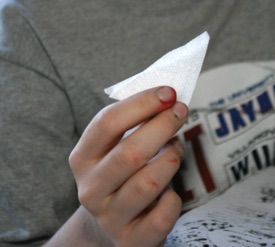
A simple triangle (left) folded in half (right)
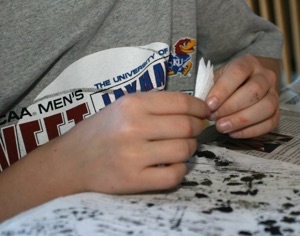
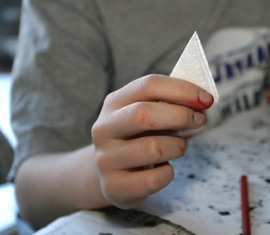
...and folded in half a second time
Take the triangle which results, and begin to roll the tip between your fingers to twist it. Twist the paper into a wick as shown.
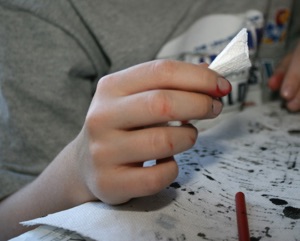

Twist first the tip (left), and then the entire paper (right)

The resulting wick
Once you’ve created the wick, you need to carefully insert it into the hole at the bottom of your egg.
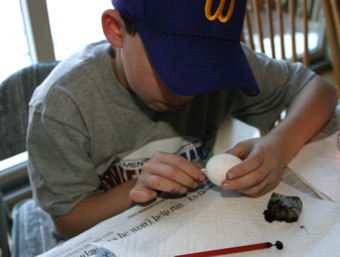
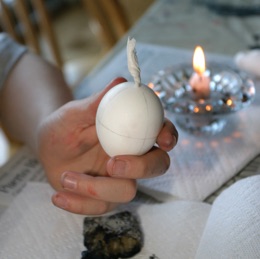
Inserting the wick (left) and view of the inserted wick (right)
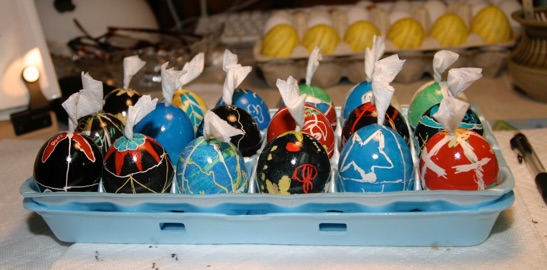
Varnished pysanky with inserted wicks
Once you have inserted the wick, the egg should be tipped over, wick down, to let it drain. This can be done on a drying board (the sort used for drying varnished eggs), or in a paper egg carton. A styrofoam carton should be used only if there is no other option, as the water puddles in the bottom of the egg cup instead of wicking away. The water can seep into the space between the varnish and the eggshell and cause damage to the dye.
I now drain my eggs on a special drying rack that I have made from several paper cartons. I use a 5x6 carton that I got from Costco, but a normal 2x6 or 3x6 would work just as well if you don’t need this much capacity. I use three layers of carton, and cut the bottoms of the egg cups out of the first two layers (this is easily accomplished with a good pair of scissors). This photo shows one layer that has been modified:
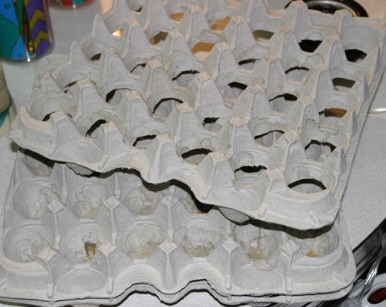
The photos below show an egg being placed in the carton, wick down, and finished pysanky (from one of my classes) draining away. These are finished pysanky; eggs being prepared would be handled the same way.


Let the eggs drain overnight, and then remove the wicks. If the tip of the wick is wet, or the entire wick is soaked, replace it, and let the egg drain for another day. If the wick is covered in eggy material, you may wish to consider rinsing the egg out with water again.
Repeat until the wick is dry upon removal.
NOTE: If you must use a styrofoam carton, you might consider doing the following: take two styrofoam cartons, and cut the top away from the bottom in each. Trim away excess flaps. Cut off the bottoms of the egg cups in both bottom halves, and stack one on the other. Place these stacked bottom halves into one of the top halves.
You can then place eggs, wick down, into this set-up to drain them. Letting an egg drain into a styrofoam carton otherwise risks having it sit in a puddle of water (paper wicks the water away); this can damage the eggshell, as the water seeps under the varnish at the drain hole site and messes up the dye.
Ba Back to Main Preparations page
Back to Main Pysankarstvo page
Search my site with Google
Finishing Up

Draining the superfluous plaster from a casting



